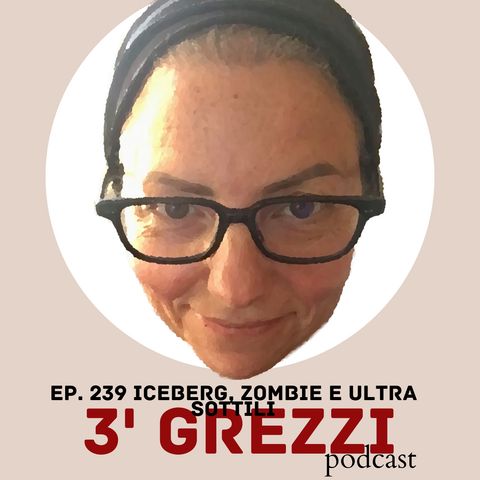3' grezzi Ep. 240 Iceberg, zombie e ultra sottili

Download and listen anywhere
Download your favorite episodes and enjoy them, wherever you are! Sign up or log in now to access offline listening.
Description
Appartementi che non rispondono più alle esigenze abitative ma solo alle leggi del profitto. Il libro "Icebergs, Zombies and the Ultra Thin: Architecture and Capitalism in the Twenty-First Century" scritto...
show moreLINK
L'articolo della preziosa We Make Money Not Art che mi ha fatto scoprire questo interessante libro https://we-make-money-not-art.com/icebergs-zombies-and-the-ultra-thin-architecture-and-capitalism-in-the-twenty-first-century/
TESTO TRASCRITTO (ENGLISH BELOW)
Oggi vi voglio parlare di un libro di architettura che mi piace un sacco anche già solo per il titolo: Icebergs, Zombies and the Ultra thin, iceberg, zombie e gli ultrasottili, con un sottotitolo che recita 'architettura e capitalismo nel ventunesimo secolo'. È un libro di Matthew Soules e parla del modo in cui a partire dagli anni '80 gli edifici siano diventati sempre di più uno strumento per accumulare ricchezza, quindi un investimento, e che quindi sempre di meno rispondono a quelle che sono le esigenze abitative delle persone che vivono in quella zona. Tra i tanti diversi modelli individuati che riflettono questo nuovo atteggiamento, appunto i tre del titolo sono abbastanza interessanti, cominciamo con gli iceberg. Cosa sono gli iceberg? Sono edifici che per ovviare ai limiti dei vari piani regolatori di città come Londra, la gente che ha un sacco di soldi compra un pezzo di terra e poi costruisce una piccola casa sopra, un piccolo appartamento e poi il resto avviene sotto terra, appunto come gli iceberg. Ci sono delle vere e proprie case di estremo lusso, questo tipo di costruzione viene chiamata il 'trogloditismo di lusso'. E qual è il problema? Il problema è che spesso queste vengono costruite, e una volta che si scava e si scava per un sacco di spazio in profondità e in larghezza sottoterra, potete ben capire quello che succede, che le case circostanti diventano sempre meno meno solide, quindi si provocano dei crolli. L'altro fenomeno del titolo è quello degli ultrasottili, e questo si spiega da solo: sono torri altissime dove la proprietà viene distribuita a scatole cinesi, quindi è anche molto difficile sapere a chi appartengono e hanno la caratteristica di rimanere quasi sempre tutti sfitti, perché non sono veramente costruiti perché la gente ci abiti ma semplicemente, ripeto, come investimento, e quello di queste torri ultrasottili porta un altro fenomeno che è quello dello zombismo, cioè questi palazzi altissimi e giganteschi che però sono quasi sempre vuoti, appunto perché non frega niente a nessuno che siano costruiti in modo che la gente ci possa andare ad abitare, quindi questo cosa porta? Porta a intere aree urbane vuote, disabitate, e questo ha un fortissimo impatto sia sul tessuto urbano che sul tipo di servizi che vengono offerti nella zona oltre che alla vivibilità. Sono sicurissima che se vi guardate intorno, in qualsiasi grande città, anche voi potrete individuare le zone zombificate.
ENGLISH TRANSLATION
Today I want to talk to you about an architecture book that I like a lot just for the title alone: Icebergs, Zombies and the Ultra thin, with a subtitle that reads 'architecture and capitalism in the twenty-first century. '. It is a book by Matthew Soules and talks about the way in which, starting from the 1980s, buildings have increasingly become a tool for accumulating wealth, therefore an investment, and therefore less and less respond to the housing needs of people who live in that area. Among the many different models identified that reflect this new attitude, the three of the title are quite interesting, let's start with the icebergs. What are icebergs? These are buildings that to overcome the limitations of the various regulatory plans of cities like London, people who have a lot of money buy a piece of land and then build a small house on it, a small apartment and then the rest takes place underground, just as the icebergs. There are real houses of extreme luxury, this type of construction is called the 'luxified troglodytism'. And what is the problem? The problem is that these are built, and once you dig and dig for a lot of space deep and wide underground, you can well understand what happens, that the surrounding houses become less and less solid, so they provoke collapses of the building around. The other phenomenon of the title is that of ultra-thin, and this is self-explanatory: they are very high towers where the property is well hidden, so it is also very difficult to know who they belong to and they have the characteristic of almost always being vacant, because they are not really built for people to live there, but simply, I repeat, as an investment, and that of these ultra-thin towers brings about another phenomenon which is that of zombism, that is, these very tall and gigantic buildings that are almost always empty, precisely because nobody gives a damn that they are built so that people can go to live there, so what does that lead to? It leads to entire empty, uninhabited urban areas, and this has a very strong impact on both the urban fabric and the type of services that are offered in the area as well as livability. I'm pretty sure that if you look around you, in any big city, you too can spot zombified areas.
Information
| Author | M. Cristina Marras |
| Organization | M. Cristina Marras |
| Website | - |
| Tags |
Copyright 2024 - Spreaker Inc. an iHeartMedia Company

Comments